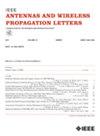EBG-Integrated Hexagonal Waveguides for Enhanced EMI Suppression in Extended C-Band Applications
IF 4.8
2区 计算机科学
Q2 ENGINEERING, ELECTRICAL & ELECTRONIC
引用次数: 0
Abstract
This letter presents a novel application of hexagonal electromagnetic bandgap (EBG) structures—each occupying a unit cell area of 2.1 cm扩展c波段应用中增强EMI抑制的ebg集成六角形波导
这封信介绍了六角形电磁带隙(EBG)结构的一种新应用——每个结构占据2.1 cm$^{2}$的单元格面积——以抑制电磁干扰,同时保持用于地面站c波段卫星通信的封闭气流。针对4.7 GHz左右的扩展C频段,提出的设计在目标下行频率下实现43 dB抑制,有效屏蔽敏感电子设备,如高性能C计算系统,即使有强制通风孔。与之前主要解决天线或平面电子设计的EBG研究不同,这项工作将EBG细胞集成到六边形通风孔中,形成波导状通道,这是一个以前没有探索过的概念。这种方法同时满足在扩展c波段频谱内运行的卫星地面站的电磁干扰(EMI)缓解和适当热管理的关键要求。该设计通过CST微波工作室的模拟和消声室的自由空间测量进行了验证,理论和实验结果非常吻合。总体而言,提出的基于ebg的解决方案提供了一种实用有效的方法,可以在不影响通风要求的情况下改善扩展c波段卫星通信机箱中的EMI控制。
本文章由计算机程序翻译,如有差异,请以英文原文为准。
求助全文
约1分钟内获得全文
求助全文
来源期刊
CiteScore
8.00
自引率
9.50%
发文量
529
审稿时长
1.0 months
期刊介绍:
IEEE Antennas and Wireless Propagation Letters (AWP Letters) is devoted to the rapid electronic publication of short manuscripts in the technical areas of Antennas and Wireless Propagation. These are areas of competence for the IEEE Antennas and Propagation Society (AP-S). AWPL aims to be one of the "fastest" journals among IEEE publications. This means that for papers that are eventually accepted, it is intended that an author may expect his or her paper to appear in IEEE Xplore, on average, around two months after submission.

 求助内容:
求助内容: 应助结果提醒方式:
应助结果提醒方式:


